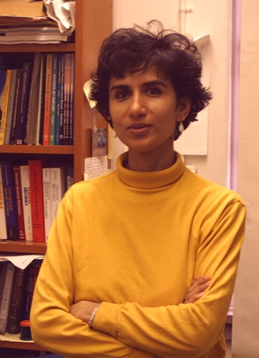 Chandralekha Singh
Chandralekha Singh
Department of Physics and Astronomy
University of Pittsburgh, Pittsburgh, PA 15260
clsingh@pitt.edu
Education
Indian Institute of Technology, Kharagpur, Physics, B.S., 1986
University of California Santa Barbara, Physics, M. A., 1989
University of California Santa Barbara, Physics, Ph.D., 1993
Professional Experience
2014-: Founding Director, Discipline-based Science Education Research Center (dB-SERC), University of Pittsburgh
2011-: Professor, University of Pittsburgh
2009-: Center Associate, Learning Research and Development Center (LRDC), University of Pittsburgh
2005-2011: Associate Professor, University of Pittsburgh
2001-2005: Senior Lecturer, University of Pittsburgh
1995-2001: Lecturer/Research Associate, University of Pittsburgh
1993-1995: Postdoctoral Fellow, University of Illinois Urbana-Champaign
Honors
University/Post-Secondary Educator Award, Carnegie Science Center, Pittsburgh, 2017;
Fellow, American Association of Physics Teachers (AAPT), 2014;
Distinguished Service Citation, AAPT, 2012;
Fellow, American Physical Society (APS) 2011;
Distinguished Visiting Scholar, Institute for Teaching and Learning, University of Akron, 2005;
Keynote Speaker, Ohio Learning Network Institute, Kent State University, 2005;
Chancellor's Distinguished Teaching Award, University of Pittsburgh, 2002;
School of Arts & Sciences Bellet Teaching Excellence Award, University of Pittsburgh, 2000;
Student Government Board Faculty Honor Roll, University of Pittsburgh, 2000;
Ferrando Fithian Award in Physics, University of California Santa Barbara, CA, 1990.
AAPT/APS Leadership Activities
Held the Chair line of the APS Forum on Education (2009-2013): Vice-chair (2009-2010), Chair-elect (2010-2011), Chair (2011-2012) and Past-Chair (2012-2013);
Chair, Editorial Board, Physical Review ST PER (2010-2013);
Guest co-editor, American Journal of Physics, May issue (2010);
Co-editor, Proceedings of the Physics Education Research Conference, (2009-2011),
Vice Chair, AAPT Committee on Women in physics (2017-2018);
Chair, AAPT Committee on International Physics Education (2014-2015);
Chair, AAPT Committee on Graduate Education in Physics (2009-2011);
Executive member of the APS Committee on Education (COE) 2005-2008, 2010-2013;
Chair, Second conference on graduate education in physics organized by APS and AAPT, MD (2013);
Co-organizer/Steering Committee member of the first conference and third conference (joint with the Bridge Program) on Graduate Education in Physics, MD, (2008) and (2017);
Co-organizer of the Physics Education Research Conferences, Syracuse, NY, (2006) and Greensboro, NC, (2007);
Workshop leader at the National and/or Regional AAPT and APS meetings on Implications of cognitive research to teaching physics, Research-based tools for teaching quantum mechanics, and Strategies to help women at all levels succeed in physics related professions;
Chair, Nominating Committee of the APS Forum on Education, (2009-2010);
Chair, Program Committee of the APS Forum on Education for both the March and April meetings, (2010-2011);
Chair, Fellowship Committee of the APS Forum on Education, (2011-2012);
Member of the AAPT Special Projects and Philanthropy Committee (2015-2017);
Member of the AAPT Jossem International Education Fund Committee (2014-2016);
Co-editor, APS Forum on Education Newsletter, Fall (2009) and Fall (2010).
Other Leadership Activities
Co-chair of the first Conference on the Future of Materials Science and Engineering Education, (2008);
Co-chair for the Gordon Conference on Physics Research and Education, (2010);
Co-vice chair for the Gordon Conference on Physics Research and Education, (2008);
Co-Team Leader of the US delegation to the 6th International conference on Women in Physics, UK, (2017);
Co-editor of the Proceedings of the 6th International Conference on Women in Physics, UK, (2017-2018);
Member of the US delegation to the 5th International conference on Women in Physics, Canada, (2014);
Workshop leader/panelist at the Conference on Undergraduate Women in Physics (CUWIP) (Penn State 2014, Princeton 2017).
Commentary
It is a great honor to be nominated for the position of AAPT Vice-President. This position comes with the opportunity to lead an organization that I revere and work with dedicated and enthusiastic colleagues who share my passion for enhancing the understanding and appreciation of physics through teaching.
I attended my first AAPT meeting in 1999 after pursuing research in physics education for several years. I knew then that I had found a professional home. I strongly believe that one of the unique strengths of AAPT as an organization is that it brings together K-12 and college educators who share the same passion and enthusiasm for improving the teaching and learning of physics. This community has inspired me in many ways, and I have learned a lot from many AAPT members, regardless of whether their focus is on teaching at the middle school, high school, or college level.
If elected to the Presidential chain, I will continue to build on the great work of our past and current leadership to make AAPT an even stronger organization. In addition to my staunch commitment to AAPT's mission and goals, my ability to work effectively with others and my organizational skills will be major assets in accomplishing the various tasks in the Presidential chain. In addition to my other responsibilities, I will work to:
- Leverage AAPT's strength and find novel ways to strengthen the connections and build partnerships between K-12 and college educators
- Continue to enhance opportunities for professional growth of AAPT members via conferences and dissemination of information about resources available through AAPT
- Develop and implement strategies to attract new members to AAPT both from K-12 and college levels
- Counteract anti-science sentiment by organizing (or co-sponsoring) events that increase public awareness and appreciation for science (and physics, specifically).

